Overview
Aerobase is a single sign on solution for web apps and RESTful web services. The goal of Aerobase is to make security simple so that it is easy for application developers to secure the apps and services they have deployed in their organization. Security features that developers normally have to write for themselves are provided out of the box and are easily tailorable to the individual requirements of your organization. Aerobase provides customizable user interfaces for login, registration, administration, and account management. You can also use Aerobase as an integration platform to hook it into existing LDAP and Active Directory servers. You can also delegate authentication to third party identity providers like Facebook and Google+.
Features
-
Single-Sign On and Single-Sign Out for browser applications.
-
OpenID Connect support.
-
OAuth 2.0 support.
-
SAML support.
-
Identity Brokering - Authenticate with external OpenID Connect or SAML Identity Providers.
-
Social Login - Enable login with Google, GitHub, Facebook, Twitter, and other social networks.
-
User Federation - Sync users from LDAP and Active Directory servers.
-
Kerberos bridge - Automatically authenticate users that are logged-in to a Kerberos server.
-
Admin Console for central management of users, roles, role mappings, clients and configuration.
-
Account Management console that allows users to centrally manage their account.
-
Theme support - Customize all user facing pages to integrate with your applications and branding.
-
Two-factor Authentication - Support for TOTP/HOTP via Google Authenticator or FreeOTP.
-
Login flows - optional user self-registration, recover password, verify email, require password update, etc.
-
Session management - Admins and users themselves can view and manage user sessions.
-
Token mappers - Map user attributes, roles, etc. how you want into tokens and statements.
-
Not-before revocation policies per realm, application and user.
-
CORS support - Client adapters have built-in support for CORS.
-
Service Provider Interfaces (SPI) - A number of SPIs to enable customizing various aspects of the server. Authentication flows, user federation providers, protocol mappers and many more.
-
Client adapters for JavaScript applications, WildFly, JBoss EAP, Fuse, Tomcat, Jetty, Spring, etc.
-
Supports any platform/language that has an OpenID Connect Relying Party library or SAML 2.0 Service Provider library.
How Does Security Work?
Aerobase is a separate server that you manage on your network. Applications are configured to point to and be secured by this server. Aerobase uses open protocol standards like OpenID Connect or SAML 2.0 to secure your applications. Browser applications redirect a user’s browser from the application to the Aerobase authentication server where they enter their credentials. This is important because users are completely isolated from applications and applications never see a user’s credentials. Applications instead are given an identity token or assertion that is cryptographically signed. These tokens can have identity information like username, address, email, and other profile data. They can also hold permission data so that applications can make authorization decisions. These tokens can also be used to make secure invocations on REST-based services.
Core Concepts and Terms
There are some key concepts and terms you should be aware of before attempting to use Aerobase to secure your web applications and REST services.
- users
-
Users are entities that are able to log into your system. They can have attributes associated with themselves like email, username, address, phone number, and birth day. They can be assigned group membership and have specific roles assigned to them.
- authentication
-
The process of identifying and validating a user.
- authorization
-
The process of granting access to a user.
- credentials
-
Credentials are pieces of data that Aerobase uses to verify the identity of a user. Some examples are passwords, one-time-passwords, digital certificates, or even fingerprints.
- roles
-
Roles identify a type or category of user.
Admin,user,manager, andemployeeare all typical roles that may exist in an organization. Applications often assign access and permissions to specific roles rather than individual users as dealing with users can be too fine grained and hard to manage. - user role mapping
-
A user role mapping defines a mapping between a role and a user. A user can be associated with zero or more roles. This role mapping information can be encapsulated into tokens and assertions so that applications can decide access permissions on various resources they manage.
- composite roles
-
A composite role is a role that can be associated with other roles. For example a
superusercomposite role could be associated with thesales-adminandorder-entry-adminroles. If a user is mapped to thesuperuserrole they also inherit thesales-adminandorder-entry-adminroles. - groups
-
Groups manage groups of users. Attributes can be defined for a group. You can map roles to a group as well. Users that become members of a group inherit the attributes and role mappings that group defines.
- realms
-
A realm manages a set of users, credentials, roles, and groups. A user belongs to and logs into a realm. Realms are isolated from one another and can only manage and authenticate the users that they control.
- clients
-
Clients are entities that can request Aerobase to authenticate a user. Most often, clients are applications and services that want to use Aerobase to secure themselves and provide a single sign-on solution. Clients can also be entities that just want to request identity information or an access token so that they can securely invoke other services on the network that are secured by Aerobase.
- client adapters
-
Client adapters are plugins that you install into your application environment to be able to communicate and be secured by Aerobase. Aerobase has a number of adapters for different platforms that you can download. There are also third-party adapters you can get for environments that we don’t cover.
- consent
-
Consent is when you as an admin want a user to give permission to a client before that client can participate in the authentication process. After a user provides their credentials, Aerobase will pop up a screen identifying the client requesting a login and what identity information is requested of the user. User can decide whether or not to grant the request.
- client scopes
-
When a client is registered, you must define protocol mappers and role scope mappings for that client. It is often useful to store a client scope, to make creating new clients easier by sharing some common settings. This is also useful for requesting some claims or roles to be conditionally based on the value of
scopeparameter. Aerobase provides the concept of a client scope for this. - client role
-
Clients can define roles that are specific to them. This is basically a role namespace dedicated to the client.
- identity token
-
A token that provides identity information about the user. Part of the OpenID Connect specification.
- access token
-
A token that can be provided as part of an HTTP request that grants access to the service being invoked on. This is part of the OpenID Connect and OAuth 2.0 specification.
- assertion
-
Information about a user. This usually pertains to an XML blob that is included in a SAML authentication response that provided identity metadata about an authenticated user.
- service account
-
Each client has a built-in service account which allows it to obtain an access token.
- direct grant
-
A way for a client to obtain an access token on behalf of a user via a REST invocation.
- protocol mappers
-
For each client you can tailor what claims and assertions are stored in the OIDC token or SAML assertion. You do this per client by creating and configuring protocol mappers.
- session
-
When a user logs in, a session is created to manage the login session. A session contains information like when the user logged in and what applications have participated within single-sign on during that session. Both admins and users can view session information.
- user federation provider
-
Aerobase can store and manage users. Often, companies already have LDAP or Active Directory services that store user and credential information. You can point Aerobase to validate credentials from those external stores and pull in identity information.
- identity provider
-
An identity provider (IDP) is a service that can authenticate a user. Aerobase is an IDP.
- identity provider federation
-
Aerobase can be configured to delegate authentication to one or more IDPs. Social login via Facebook or Google+ is an example of identity provider federation. You can also hook Aerobase to delegate authentication to any other OpenID Connect or SAML 2.0 IDP.
- identity provider mappers
-
When doing IDP federation you can map incoming tokens and assertions to user and session attributes. This helps you propagate identity information from the external IDP to your client requesting authentication.
- required actions
-
Required actions are actions a user must perform during the authentication process. A user will not be able to complete the authentication process until these actions are complete. For example, an admin may schedule users to reset their passwords every month. An
update passwordrequired action would be set for all these users. - authentication flows
-
Authentication flows are work flows a user must perform when interacting with certain aspects of the system. A login flow can define what credential types are required. A registration flow defines what profile information a user must enter and whether something like reCAPTCHA must be used to filter out bots. Credential reset flow defines what actions a user must do before they can reset their password.
- events
-
Events are audit streams that admins can view and hook into.
- themes
-
Every screen provided by Aerobase is backed by a theme. Themes define HTML templates and stylesheets which you can override as needed.
Server Initialization
After performing all the installation and configuration tasks defined in the Server Installation and Configuration Guide, you will need to create an initial admin account. Aerobase does not have any configured admin account out of the box. This account will allow you to create an admin that can log into the master realm’s administration console so that you can start creating realms, users and registering applications to be secured by Aerobase.
If your
server is accessible from localhost, you can boot it up and create this admin user by going to the http://localhost/auth/admin/aerobase/console URL.

Simply specify the username and password (admin/123) you want for this initial admin.
If you cannot access the server via a localhost address, or just want to activate Aerobase master from the command line
you can do this with the aerobase-ctl recover script.
The parameters are a little different depending on your deployment OS. here is how you use the script.
$ aerobase-ctl recover <password>> aerobase-ctl.bat recover <password>|
Reboot
|
The Master Realm
By default, Aerobase disables access to the master realm. For beginners, we recommend that you skip this section, and do not use the master realm to manage the users and applications in your organization.
Reserve use of the master realm for super admins to create and manage the realms in your system. Following this security model helps prevent accidental changes and follows the tradition of permitting user accounts access to only those privileges and powers necessary for the successful completion of their current task.
Once you execute aerobase-ctl.bat recover and boot Aerobase for the first time
Aerobase creates a pre-defined realm for you. This initial realm is the master realm. It is the highest level in the hierarchy of realms. Admin accounts in this realm have permissions to view and manage any other realm created on the server instance. When you define your initial admin account, you create an account in the
master realm. Your initial login to the admin console will also be via the
master realm.
It is possible to disable the master realm and define admin accounts within each individual new realm you create. Each realm has its own dedicated Admin Console that you can log into with local accounts. This guide talks more about this in the Dedicated Realm Admin Consoles chapter.
Admin Console

The left drop down menu allows you to pick a realm you want to manage or to create a new one. The right drop down menu allows you to view your user account or logout.
If you are curious about a certain feature, button, or field within the Admin Console, simply hover your mouse
over any question mark ? icon. This will pop up tooltip text to describe the area of the console you are interested in.
SSL Mode
Each realm has an SSL Mode associated with it. The SSL Mode defines the SSL/HTTPS requirements for interacting with the realm. Browsers and applications that interact with the realm must honor the SSL/HTTPS requirements defined by the SSL Mode or they will not be allowed to interact with the server.
| Aerobase generates a self-signed certificate the first time it runs. Please note that self-signed certificates are not secure, and should only be used for testing purposes. It is highly recommended that you install a CA-signed certificate on the Aerobase server itself or on a reverse proxy in front of the Aerobase server. See the Server Installation and Configuration Guide. |
To configure the SSL Mode of your realm, you need to click on the Realm Settings left menu item and go to the Login tab.
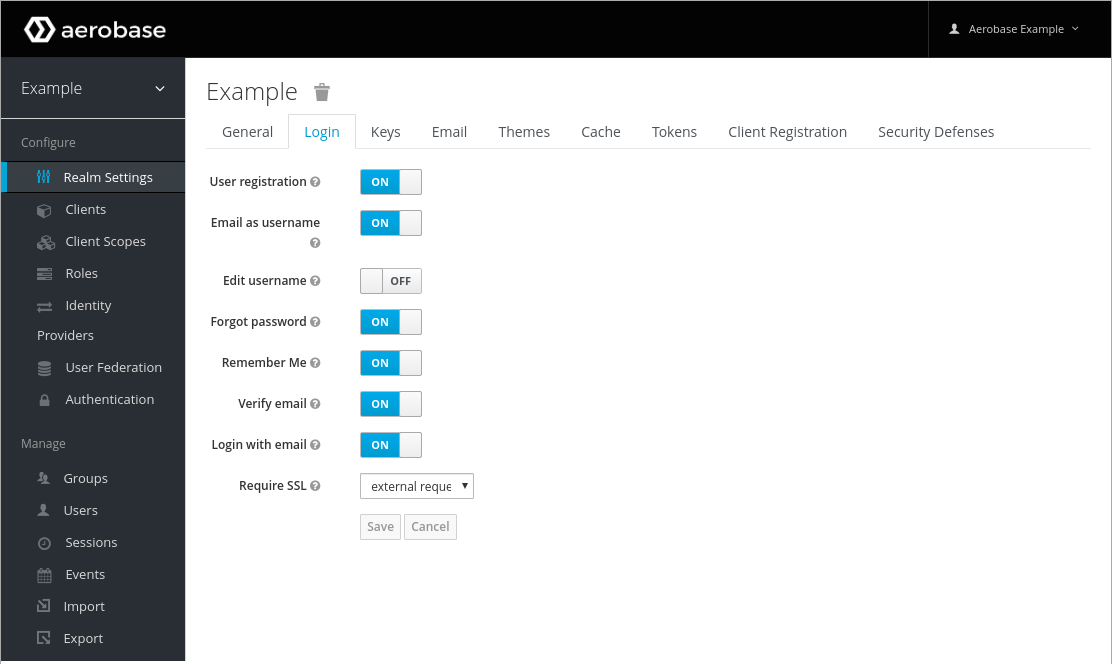
The Require SSL option allows you to pick the SSL Mode you want. Here is an explanation of each mode:
- external requests
-
Users can interact with Aerobase without SSL so long as they stick to private IP addresses like
localhost,127.0.0.1,10.0.x.x,192.168.x.x, and172.16.x.x. If you try to access Aerobase without SSL from a non-private IP address you will get an error. - none
-
Aerobase does not require SSL. This should really only be used in development when you are playing around with things and don’t want to bother configuring SSL on your server.
- all requests
-
Aerobase requires SSL for all IP addresses.
Clearing Server Caches
Aerobase will cache everything it can in memory within the limits of your JVM and/or the limits you’ve configured
it for. If the Aerobase database is modified by a third party (i.e. a DBA) outside the scope of the server’s REST APIs or Admin Console
there’s a chance parts of the in-memory cache may be stale. You can clear the realm cache, user cache or cache of external public keys (Public keys of
external clients or Identity providers, which Aerobase usually uses to verify signatures of particular external entity) from the Admin Console by going
to the Realm Settings left menu item and the Cache tab.
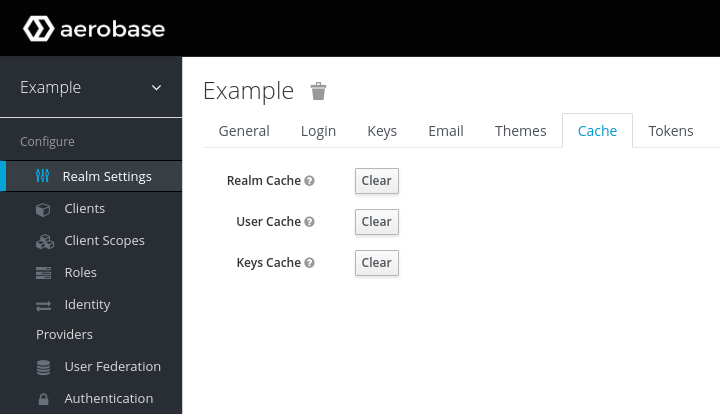
Just click the clear button on the cache you want to evict.
Email Settings
Aerobase sends emails to users to verify their email address, when they forget their passwords, or when an admin needs to
receive notifications about a server event.
To enable Aerobase to send emails you need to provide Aerobase with your SMTP server settings.
This is configured per realm. Go to the Realm Settings left menu
item and click the Email tab.
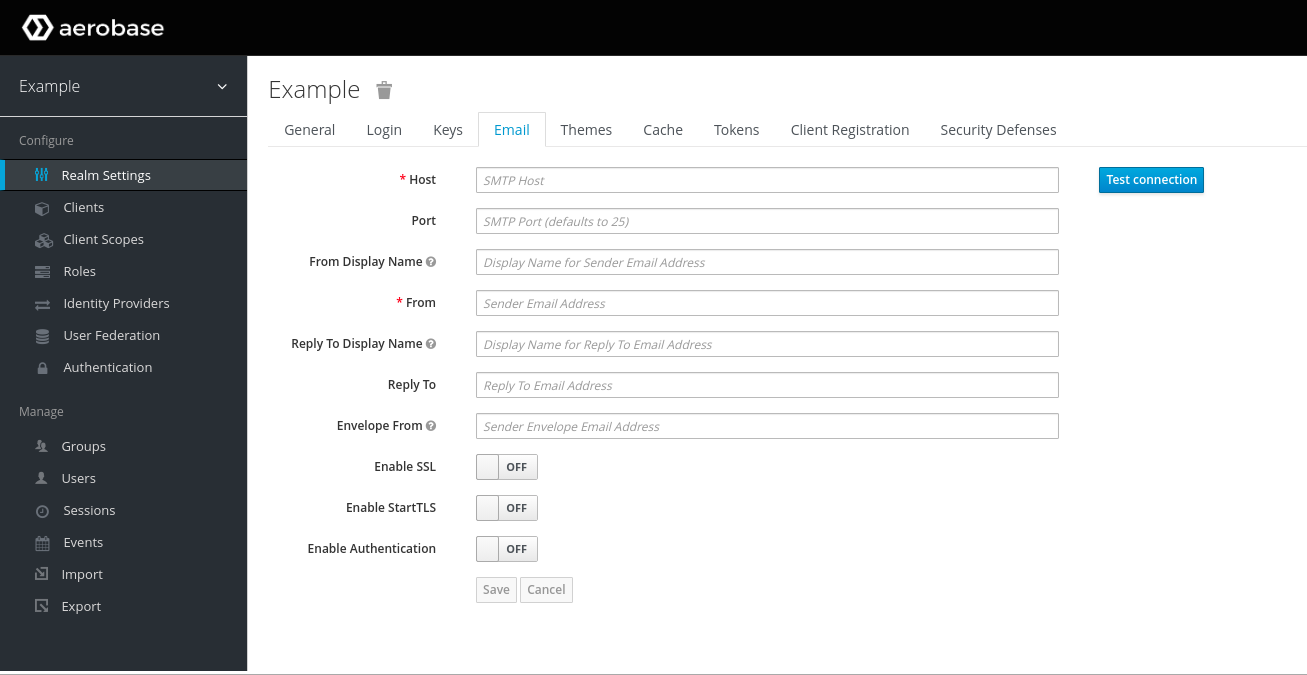
- Host
-
Hostdenotes the SMTP server hostname used for sending emails. - Port
-
Portdenotes the SMTP server port. - From
-
Fromdenotes the address used for theFromSMTP-Header for the emails sent. - From Display Name
-
From Display Nameallows to configure a user friendly email address aliases (optional). If not set the plainFromemail address will be displayed in email clients. - Reply To
-
Reply Todenotes the address used for theReply-ToSMTP-Header for the mails sent (optional). If not set the plainFromemail address will be used. - Reply To Display Name
-
Reply To Display Nameallows to configure a user friendly email address aliases (optional). If not set the plainReply Toemail address will be displayed. - Envelope From
-
Envelope Fromdenotes the Bounce Address used for theReturn-PathSMTP-Header for the mails sent (optional).
As emails are used for recovering usernames and passwords it’s recommended to use SSL or TLS, especially if the SMTP server is on an external network.
To enable SSL click on Enable SSL or to enable TLS click on Enable TLS.
You will most likely also need to change the Port (the default port for SSL/TLS is 465).
If your SMTP server requires authentication click on Enable Authentication and insert the Username and Password.
Themes and Internationalization
Themes allow you to change the look and feel of any UI in Aerobase. Themes are configured per realm. To change
a theme go to the Realm Settings left menu item and click on the Themes tab.

Pick the theme you want for each UI category and click Save.
- Login Theme
-
Username password entry, OTP entry, new user registration, and other similar screens related to login.
- Account Theme
-
Each user has an User Account Management UI.
- Admin Console Theme
-
The skin of the Aerobase Admin Console.
- Email Theme
-
Whenever Aerobase has to send out an email, it uses templates defined in this theme to craft the email.
The Server Developer Guide goes into how to create a new themes or modify existing ones.
Internationalization
Every UI screen is internationalized in Aerobase. The default language is English, but if you turn on the
Internationalization switch on the Theme tab you can choose which locales you want to support and what the default locale
will be. The next time a user logs in, they will be able to choose a language on the login page to use for the login screens,
User Account Management UI, and Admin Console. The Server Developer Guide explains
how you can offer additional languages.
Create a New Realm
To create a realm, you must first enable the master realm.
Creating a new realm is very simple.
Mouse over the top left corner drop down menu that is titled with Master. If you are logged in the master realm
this drop down menu lists all the realms created. The last entry of this drop down menu is always Add Realm. Click
this to add a realm.

This menu option will bring you to the Add Realm page. Specify the realm name you want to define and click the Create button.
Alternatively you can import a JSON document that defines your new realm. We’ll go over this in more detail in the
Export and Import chapter.

After creating the realm you are brought back to the main Admin Console page. The current realm will now be set to the realm you just created. You can switch between managing different realms by doing a mouse over on the top left corner drop down menu.
User Management
This section describes the administration functions for managing users.
Searching For Users
If you need to manage a specific user, click on Users in the left menu bar.

This menu option brings you to the user list page. In the search box you can type in a full name, last name, or email address
you want to search for in the user database. The query will bring up all users that match your criteria. The View all users button
will list every user in the system. This will search just local Aerobase database and not the federated database (ie. LDAP)
because some backends like LDAP don’t have a way to page through users. So if you want the users from federated backend to be synced into Aerobase
database you need to either:
-
Adjust search criteria. That will sync just the backend users matching the criteria into Aerobase database.
-
Go to
User Federationtab and clickSync all usersorSync changed usersin the page with your federation provider.
See User Federation for more details.
Creating New Users
To create a user click on Users in the left menu bar.

This menu option brings you to the user list page. On the right side of the empty user list, you should see an Add User
button. Click that to start creating your new user.

The only required field is Username. Click save. This will bring you to the management page for your new user.
Deleting Users
To delete a user click on Users in the left menu bar.

This menu option brings you to the user list page. Click View all users or search to find the user you intend to delete.

In the list of users, click Delete next to the user you want to remove. You will be asked to confirm that you are sure you want to delete this user. Click Delete in the confirmation box to confirm.
User Attributes
Beyond basic user metadata like name and email, you can store arbitrary user attributes. Choose a user to manage
then click on the Attributes tab.

Enter in the attribute name and value in the empty fields and click the Add button next to it to add a new field.
Note that any edits you make on this page will not be stored until you hit the Save button.
User Credentials
When viewing a user if you go to the Credentials tab you can manage a user’s credentials.
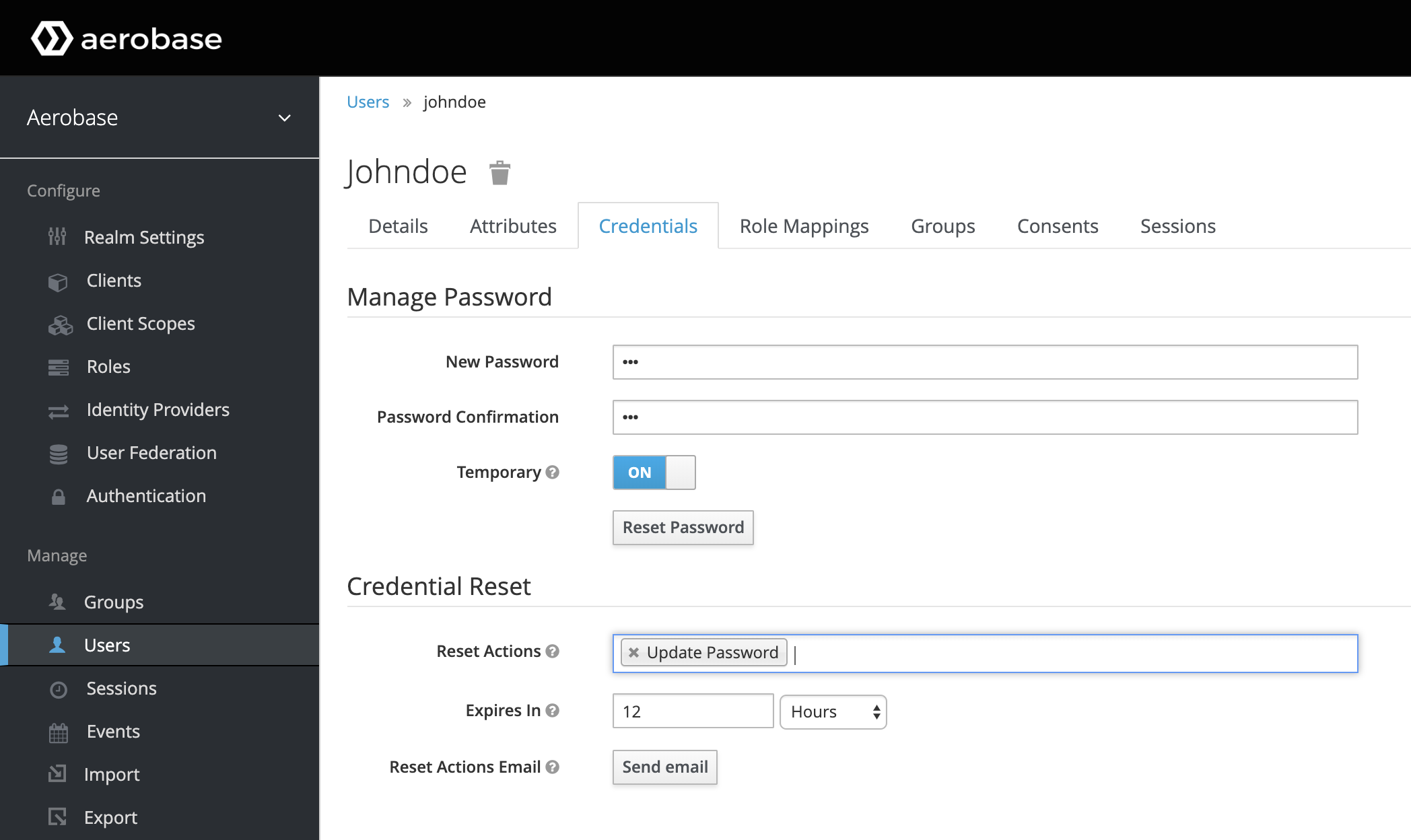
Changing Passwords
To change a user’s password, type in a new one. A Reset Password button will show up that you click after you’ve typed everything in.
If the Temporary switch is on, this new password can only be used once and the user will be asked to change their password after they have
logged in.
Alternatively, if you have email set up, you can send an email to the user that asks
them to reset their password. Choose Update Password from the Reset Actions list box and click Send Email. You can optionally
set the validity of the e-mail link which defaults to the one preset in Tokens tab in the realm settings.
The sent email contains a link that will bring the user to the update password screen.
Changing OTPs
You cannot configure One-Time Passwords for a specific user within the Admin Console. This is the responsibility of the user.
If the user has lost their OTP generator all you can do is disable OTP for them on the Credentials tab.
If OTP is optional in your realm, the user will have to go to the User Account Management service to re-configure a new
OTP generator. If OTP is required, then the user will be asked to re-configure a new OTP generator when they log in.
Like passwords, you can alternatively send an email to the user that will ask them to reset their OTP generator. Choose
Configure OTP in the Reset Actions list box and click the Send Email button. The sent email
contains a link that will bring the user to the OTP setup screen.
Required Actions
Required Actions are tasks that a user must finish before they are allowed to log in. A user must provide their credentials before required actions are executed. Once a required action is completed, the user will not have to perform the action again. Here are explanations of some of the built-in required action types:
- Update Password
-
When set, a user must change their password.
- Configure OTP
-
When set, a user must configure a one-time password generator on their mobile device using either the Free OTP or Google Authenticator application.
- Verify Email
-
When set, a user must verify that they have a valid email account. An email will be sent to the user with a link they have to click. Once this workflow is successfully completed, they will be allowed to log in.
- Update Profile
-
This required action asks the user to update their profile information, i.e. their name, address, email, and/or phone number.
Admins can add required actions for each individual user within the user’s Details tab in the Admin Console.
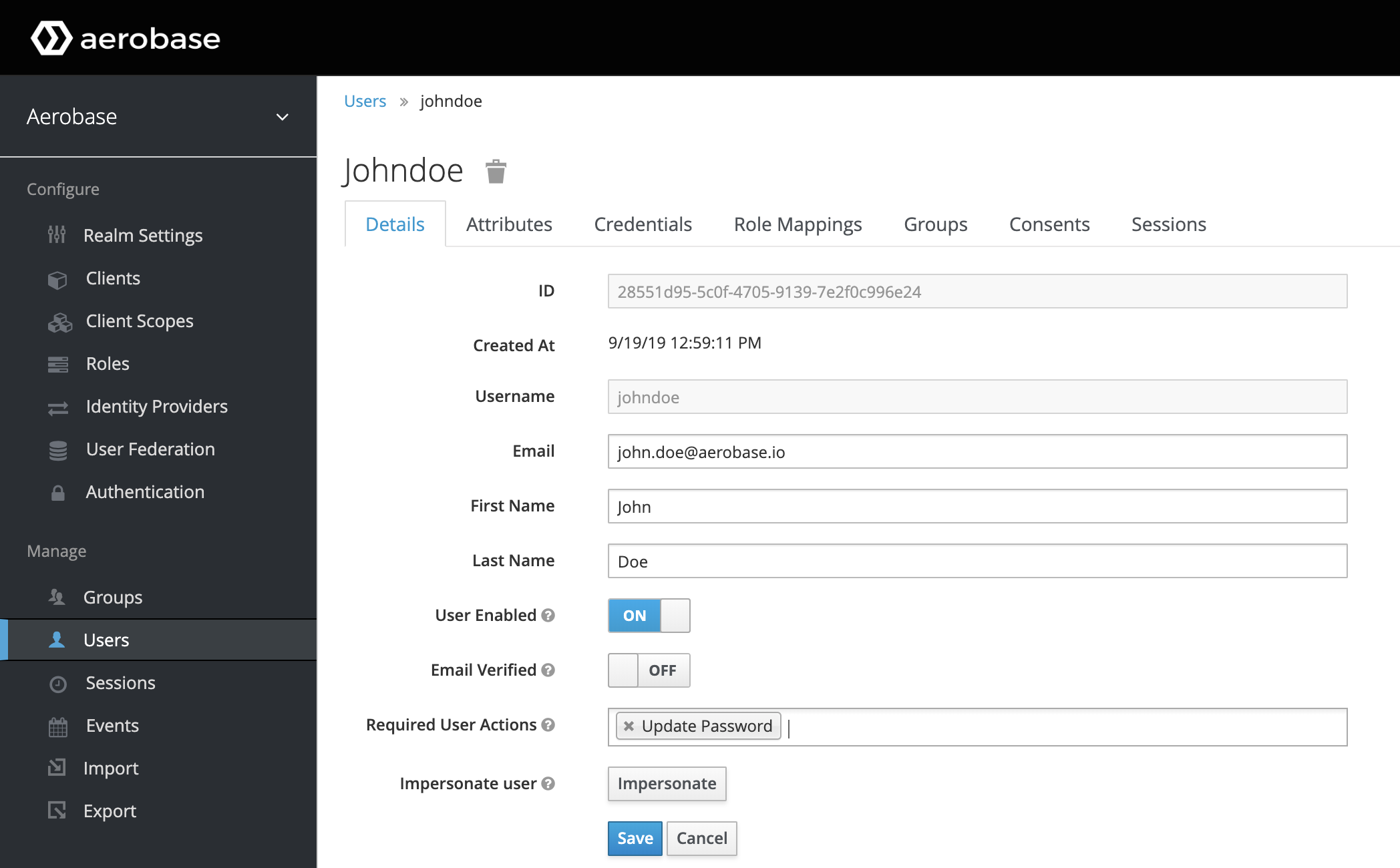
In the Required User Actions list box, select all the actions you want to add to the account. If you want to remove one, click the X next to the
action name. Also remember to click the Save button after you’ve decided what actions to add.
Default Required Actions
You can also specify required actions that will be added to an account whenever a new user is created, i.e. through the Add User button the user
list screen, or via the user registration link on the login page. To specify
the default required actions go to the Authentication left menu item and click on the Required Actions tab.

Simply click the checkbox in the Default Action column of the required actions that you want to be executed when a brand new user logs in.
Terms and Conditions
Many organizations have a requirement that when a new user logs in for the first time, they need to agree to the terms and conditions
of the website. Aerobase has this functionality implemented as a required action, but it requires some configuration. For one, you
have to go to the Required Actions tab described earlier and enable the Terms and Conditions action. You must also edit the
terms.ftl file in the base login theme. See the Server Developer Guide for more information on extending and
creating themes.
Impersonation
It is often useful for an admin to impersonate a user. For example, a user may be experiencing a bug in one of your applications and
an admin may want to impersonate the user to see if they can duplicate the problem. Admins with the appropriate permission
can impersonate a user. There are two locations an admin can initiate impersonation. The first is on the Users list tab.
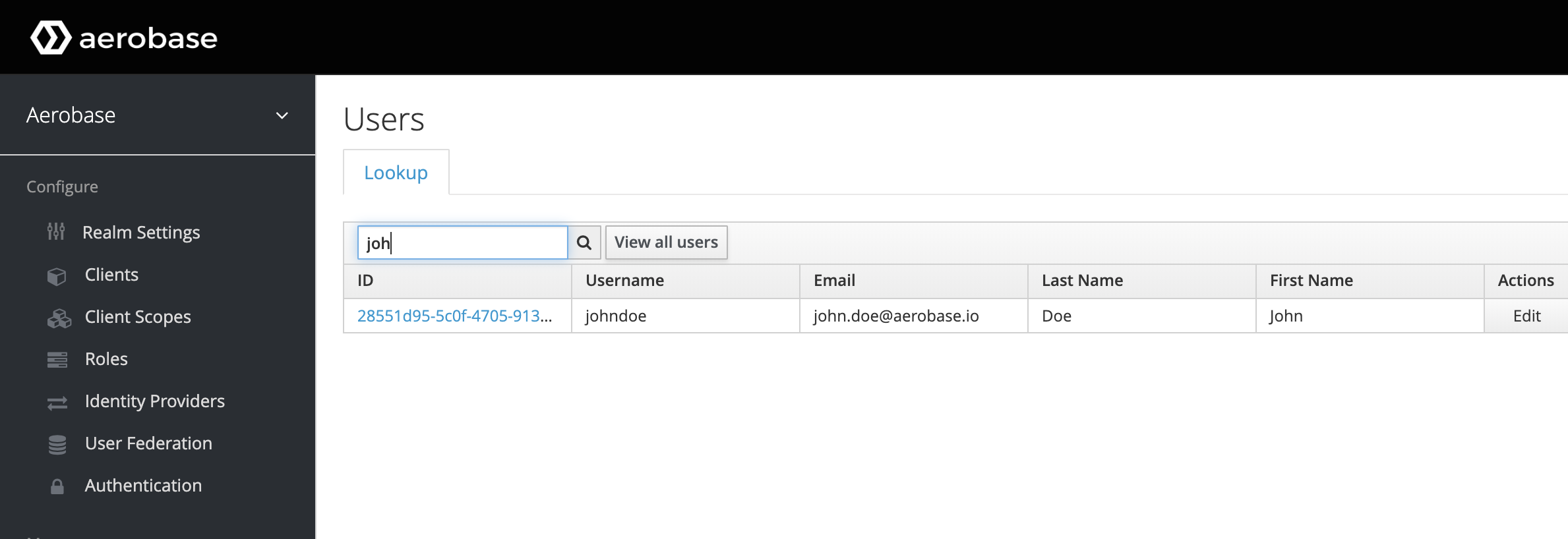
You can see here that the admin has searched for john. Next to John’s account you can see an impersonate button. Click that
to impersonate the user.
Also, you can impersonate the user from the user Details tab.
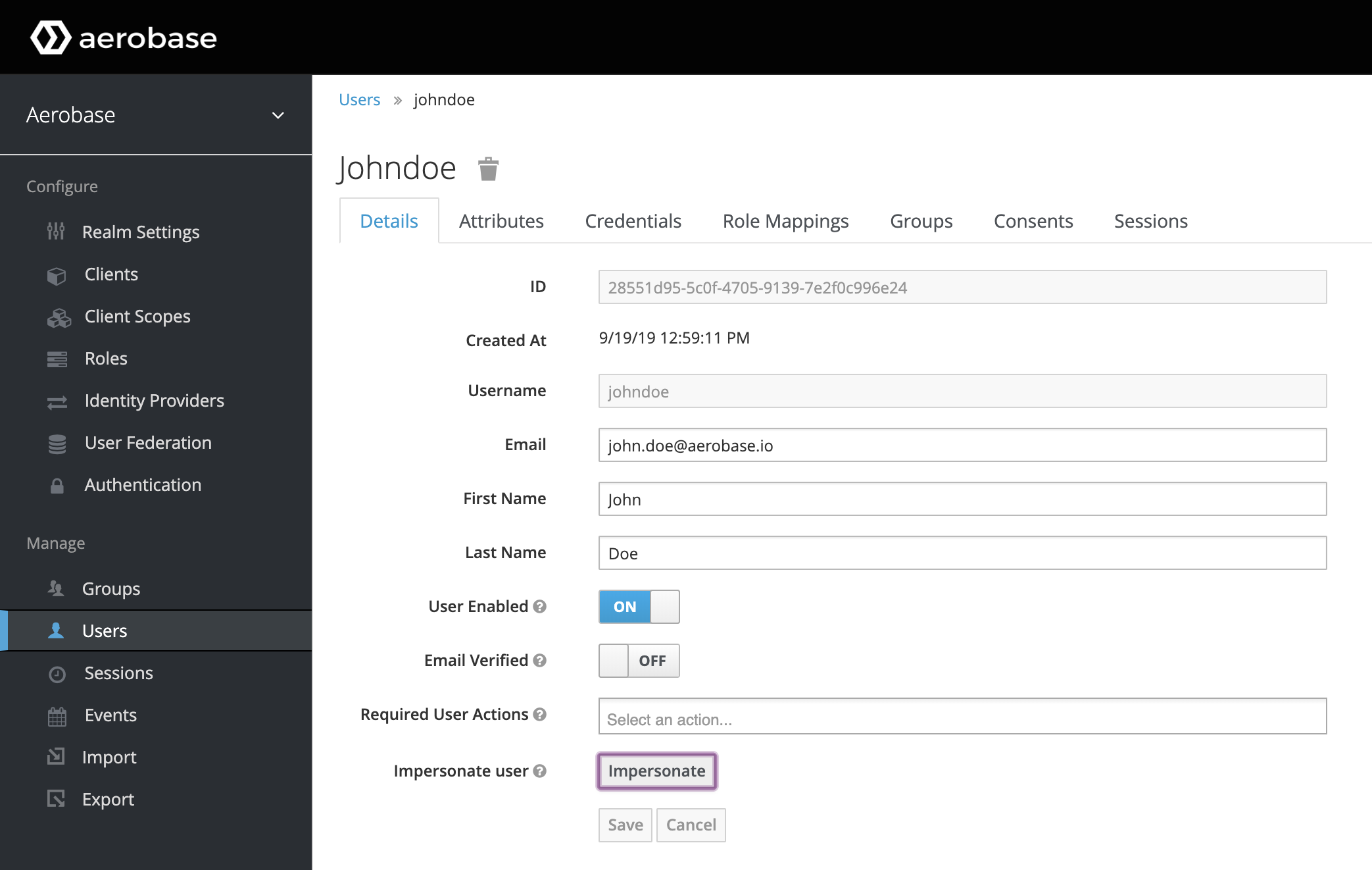
Near the bottom of the page you can see the Impersonate button. Click that to impersonate the user.
When impersonating, if the admin and the user are in the same realm, then the admin will be logged out and automatically logged in as the user being impersonated. If the admin and user are not in the same realm, the admin will remain logged in, but additionally be logged in as the user in that user’s realm. In both cases, the browser will be redirected to the impersonated user’s User Account Management page.
Any user with the realm’s impersonation role can impersonate a user. Please see the Admin Console Access Control chapter
for more details on assigning administration permissions.
User Registration
You can enable Aerobase to allow user self registration. When enabled, the login page has a registration link the user can click on to create their new account.
When user self registration is enabled it is possible to use the registration form to detect valid usernames and emails. It is also possible to enable reCAPTCHA Support.
Enabling registration is pretty simple. Go to the
Realm Settings left menu and click it. Then go to the Login tab. There is a User Registration switch on this
tab. Turn it on, then click the Save button.

After you enable this setting, a Register link should show up on the login page.
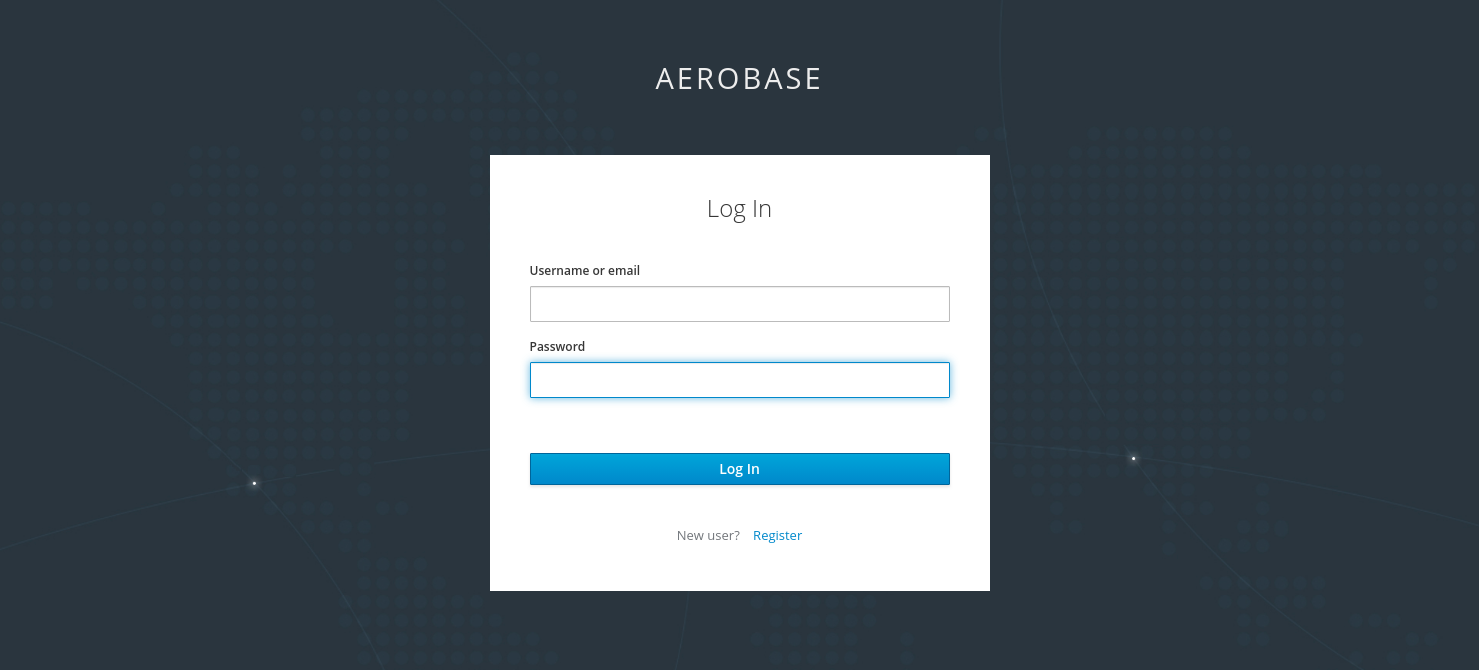
Clicking on this link will bring the user to the registration page where they have to enter in some user profile information and a new password.

You can change the look and feel of the registration form as well as removing or adding additional fields that must be entered. See the Server Developer Guide for more information.
reCAPTCHA Support
To safeguard registration against bots, Aerobase has integration with Google reCAPTCHA. To enable this you need to first go to Google Recaptcha Website and create an API key so that you can get your reCAPTCHA site key and secret. (FYI, localhost works by default so you don’t have to specify a domain).
Next, there are a few steps you need to perform in the Aerobase Admin Console.
Click the Authentication left menu item and go to the Flows tab. Select the Registration flow from the drop down
list on this page.

Set the 'reCAPTCHA' requirement to Required by clicking the appropriate radio button. This will enable
reCAPTCHA on the screen. Next, you have to enter in the reCAPTCHA site key and secret that you generated at the Google reCAPTCHA Website.
Click on the 'Actions' button that is to the right of the reCAPTCHA flow entry, then "Config" link, and enter in the reCAPTCHA site key and secret on this config page.

The final step you have to do is to change some default HTTP response headers that Aerobase sets. Aerobase
will prevent a website from including any login page within an iframe. This is to prevent clickjacking attacks. You need to
authorize Google to use the registration page within an iframe. Go to
the Realm Settings left menu item and then go to the Security Defenses tab. You will need to add https://www.google.com to the
values of both the X-Frame-Options and Content-Security-Policy headers.
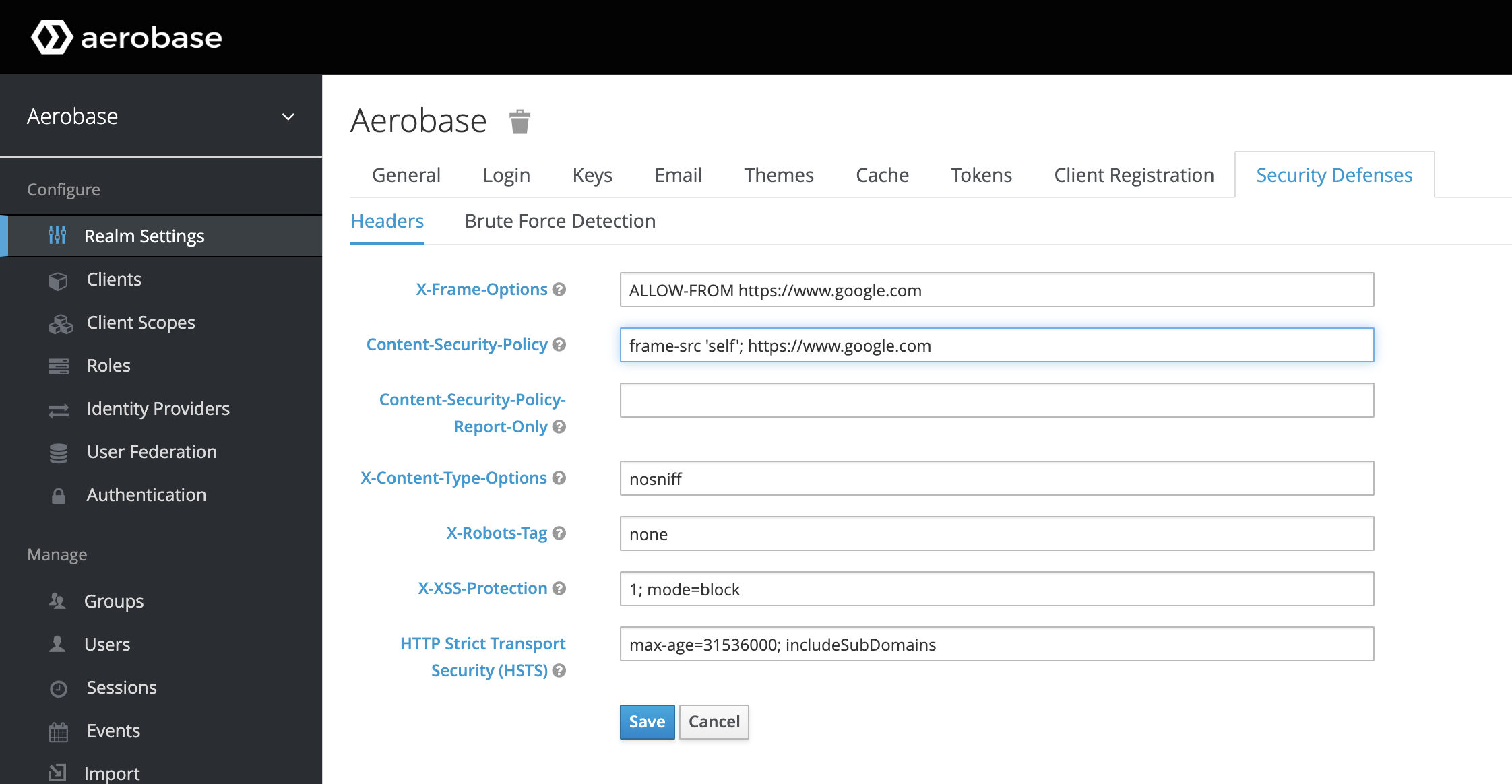
Once you do this, reCAPTCHA should show up on your registration page. You may want to edit register.ftl in your login theme to muck around with the placement and styling of the reCAPTCHA button. See the Server Developer Guide for more information on extending and creating themes.
Login Page Settings
There are several nice built-in login page features you can enable if you need the functionality.
Forgot Password
If you enable it, users are able to reset their credentials if they forget their password or lose their OTP generator.
Go to the Realm Settings left menu item, and click on the Login tab. Switch on the Forgot Password switch.

A forgot password link will now show up on your login pages.

Clicking on this link will bring the user to a page where they can enter in their username or email and receive an email with a link to reset their credentials.
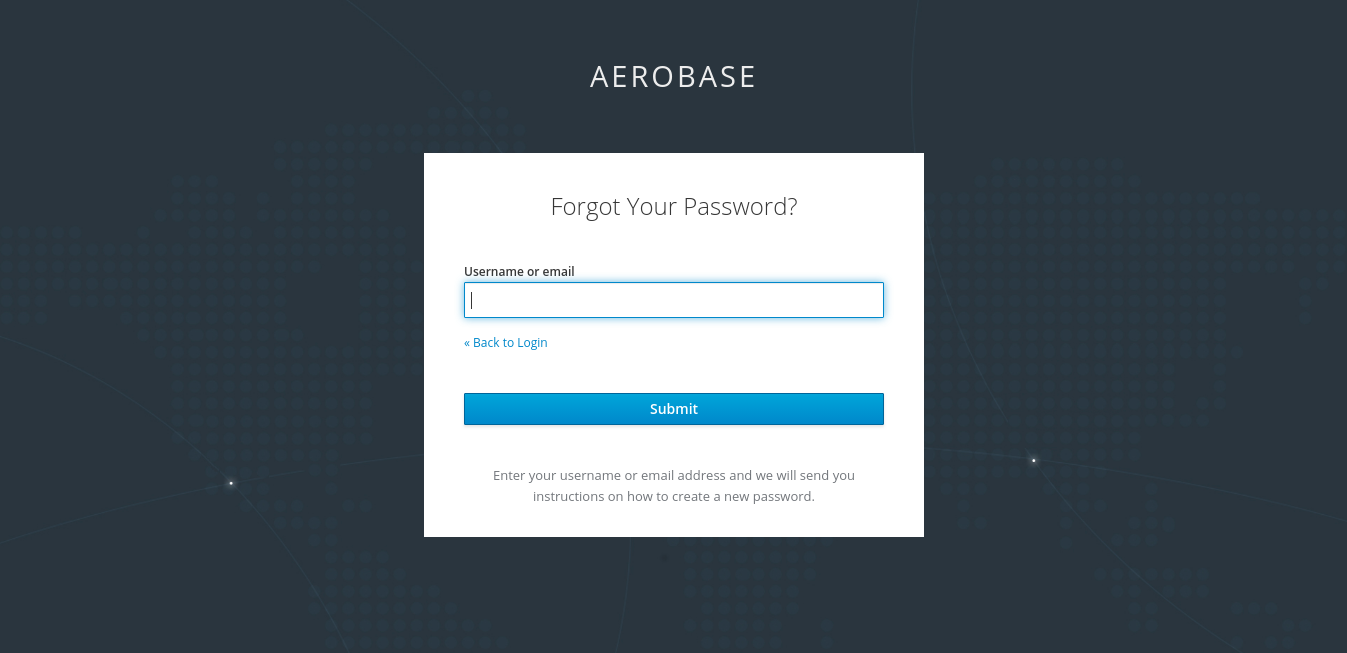
The text sent in the email is completely configurable. You just need to extend or edit the theme associated with it. See the Server Developer Guide for more information.
When the user clicks on the email link, they will be asked to update their password, and, if they have an OTP generator
set up, they will also be asked to reconfigure this as well. Depending on the security requirements of your organization
you may not want users to be able to reset their OTP generator through email. You can change this behavior by
going to the Authentication left menu item, clicking on the Flows tab, and selecting the Reset Credentials flow:
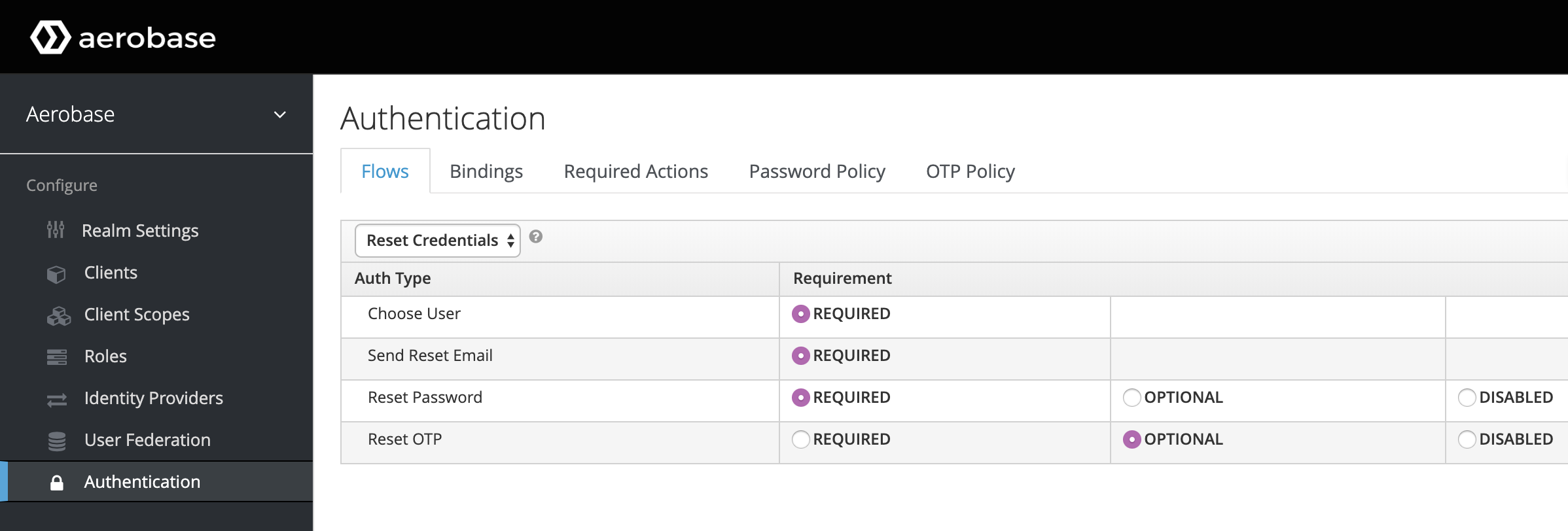
If you do not want OTP reset, then just chose the disabled radio button to the right of Reset OTP.
| Be sure to leave Update Password enabled on the Required Actions tab. Otherwise, Forgot Password does not work. |
Remember Me
If a logged in user closes their browser, their session is destroyed and they will have to log in again. You can set things up so that if a user checks a remember me checkbox, they will remain logged in even if the browser is closed. This basically turns the login cookie from a session-only cookie to a persistence cookie.
To enable this feature go to Realm Settings left menu item and click on the Login tab and turn on the Remember Me switch:

Once you save this setting, a remember me checkbox will be displayed on the realm’s login page.
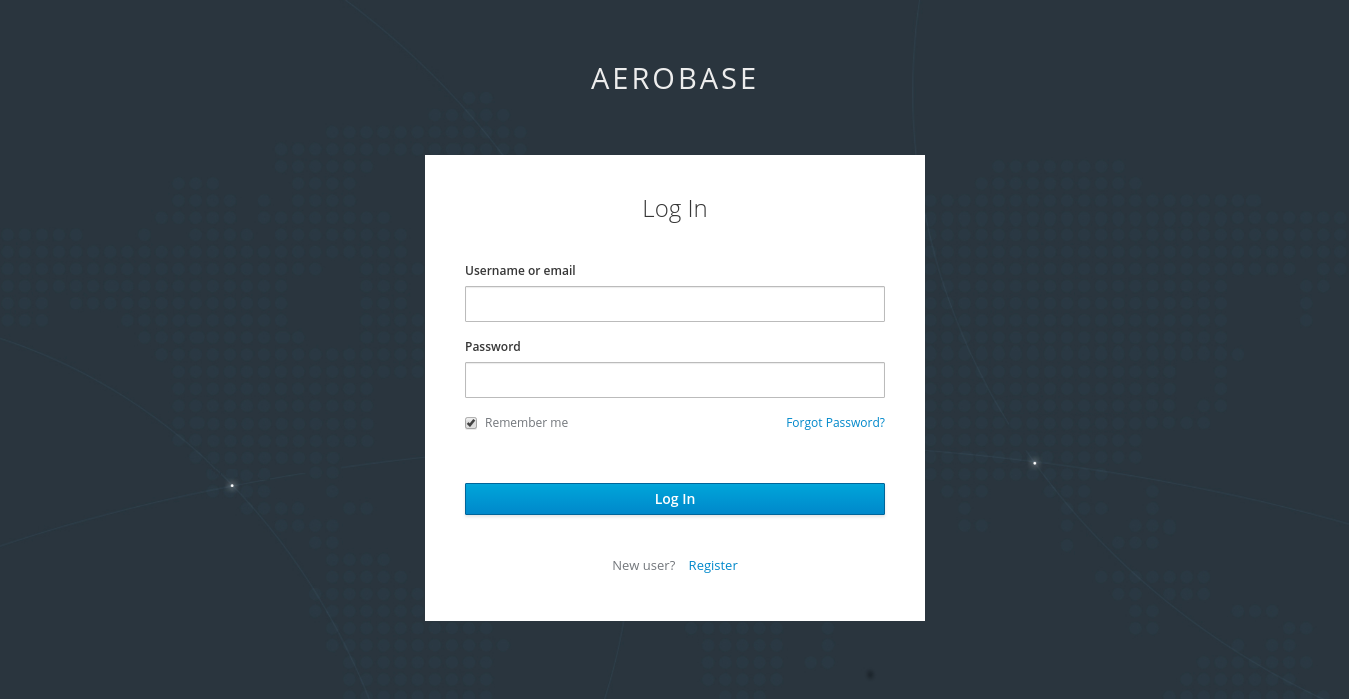
Authentication
There are a few features you should be aware of when configuring authentication for your realm. Many organizations have strict password and OTP policies that you can enforce via settings in the Admin Console. You may or may not want to require different credential types for authentication. You may want to give users the option to login via Kerberos or disable or enable various built-in credential types. This chapter covers all of these topics.
Password Policies
Each new realm created has no password policies associated with it. Users can have as short, as long, as complex, as insecure a password, as they want. Simple settings are fine for development or learning Aerobase, but unacceptable in production environments. Aerobase has a rich set of password policies you can enable through the Admin Console.
Click on the Authentication left menu item and go to the Password Policy tab. Choose the policy you want to add in the
right side drop down list box. This will add the policy in the table on the screen. Choose the parameters for the policy.
Hit the Save button to store your changes.

After saving your policy, user registration and the Update Password required action will enforce your new policy. An example of a user failing the policy check:

If the password policy is updated, an Update Password action must be set for every user. An automatic trigger is scheduled as a future enhancement.
Password Policy Types
Here’s an explanation of each policy type:
- HashAlgorithm
-
Passwords are not stored as clear text. Instead they are hashed using standard hashing algorithms before they are stored or validated. The only built-in and default algorithm available is PBKDF2. See the Server Developer Guide on how to plug in your own algorithm. Note that if you do change the algorithm, password hashes will not change in storage until the next time the user logs in.
- Hashing Iterations
-
This value specifies the number of times a password will be hashed before it is stored or verified. The default value is 20,000. This hashing is done in the rare case that a hacker gets access to your password database. Once they have access to the database, they can reverse engineer user passwords. The industry recommended value for this parameter changes every year as CPU power improves. A higher hashing iteration value takes more CPU power for hashing, and can impact performance. You’ll have to weigh what is more important to you: performance or protecting your passwords stores. There may be more cost effective ways of protecting your password stores.
- Digits
-
The number of digits required to be in the password string.
- Lowercase Characters
-
The number of lower case letters required to be in the password string.
- Uppercase Characters
-
The number of upper case letters required to be in the password string.
- Special Characters
-
The number of special characters like '?!#%$' required to be in the password string.
- Not Username
-
When set, the password is not allowed to be the same as the username.
- Regular Expression
-
Define one or more Perl regular expression patterns that passwords must match.
- Expire Password
-
The number of days for which the password is valid. After the number of days has expired, the user is required to change their password.
- Not Recently Used
-
This policy saves a history of previous passwords. The number of old passwords stored is configurable. When a user changes their password they cannot use any stored passwords.
- Password Blacklist
-
This policy checks if a given password is contained in a blacklist file, which is potentially a very large file. Password blacklists are UTF-8 plain-text files with Unix line endings where every line represents a blacklisted password. The file name of the blacklist file must be provided as the password policy value, e.g.
10_million_password_list_top_1000000.txt. Blacklist files are resolved against${jboss.server.data.dir}/password-blacklists/by default. This path can be customized via thekeycloak.password.blacklists.pathsystem property, or theblacklistsPathproperty of thepasswordBlacklistpolicy SPI configuration.
OTP Policies
Aerobase has a number of policies you can set up for your FreeOTP or Google Authenticator One-Time Password
generator. Click on the Authentication left menu item and go to the OTP Policy tab.
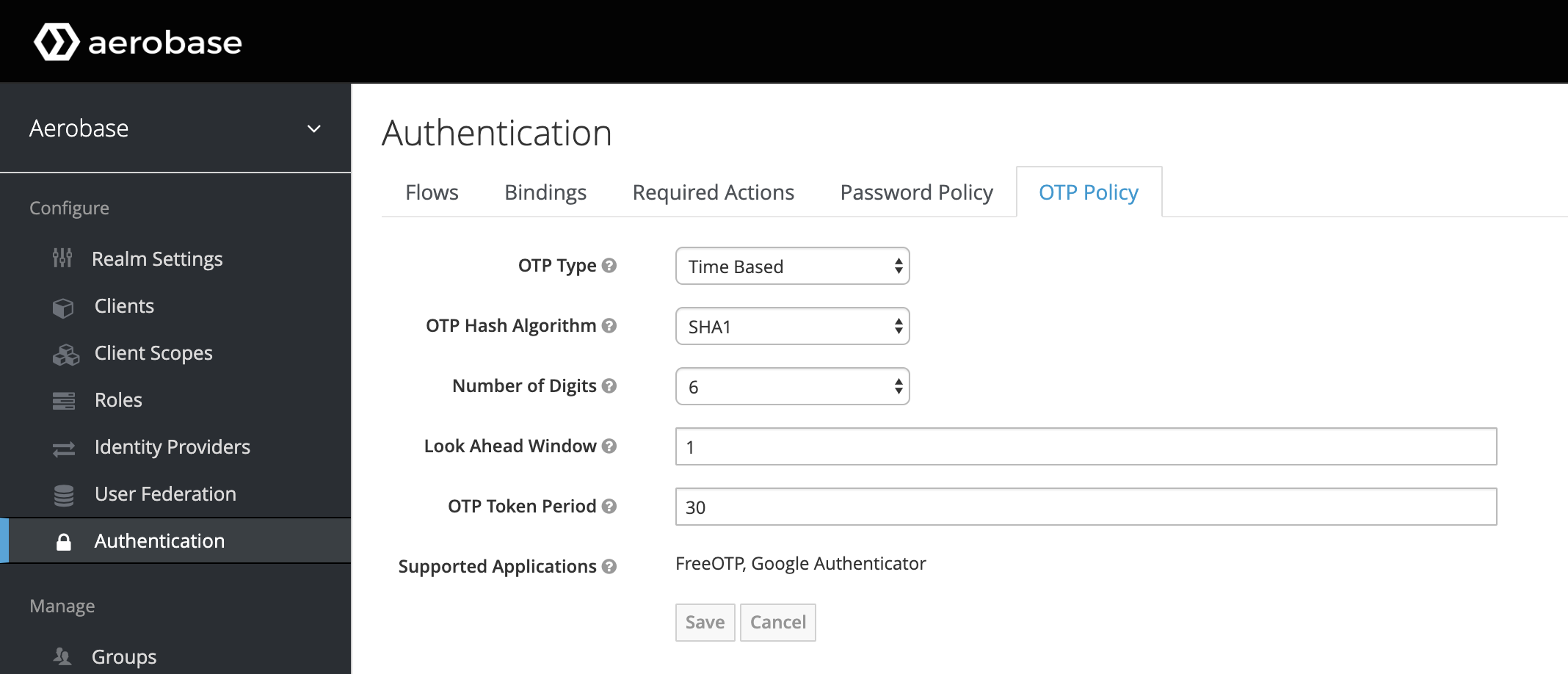
Any policies you set here will be used to validate one-time passwords. When configuring OTP, FreeOTP and Google Authenticator
can scan a QR code that is generated on the OTP set up page that Aerobase has. The bar code is also
generated from information configured on the OTP Policy tab.
TOTP vs. HOTP
There are two different algorithms to choose from for your OTP generators. Time Based (TOTP) and Counter Based (HOTP). For TOTP, your token generator will hash the current time and a shared secret. The server validates the OTP by comparing all the hashes within a certain window of time to the submitted value. So, TOTPs are valid only for a short window of time (usually 30 seconds). For HOTP a shared counter is used instead of the current time. The server increments the counter with each successful OTP login. So, valid OTPs only change after a successful login.
TOTP is considered a little more secure because the matchable OTP is only valid for a short window of time while the OTP for HOTP can be valid for an indeterminate amount of time. HOTP is much more user friendly as the user won’t have to hurry to enter in their OTP before the time interval is up. With the way Aerobase has implemented TOTP this distinction becomes a little more blurry. HOTP requires a database update every time the server wants to increment the counter. This can be a performance drain on the authentication server when there is heavy load. So, to provide a more efficient alternative, TOTP does not remember passwords used. This bypasses the need to do any DB updates, but the downside is that TOTPs can be re-used in the valid time interval. For future versions of Aerobase it is planned that you will be able to configure whether TOTP checks older OTPs in the time interval.
TOTP Configuration Options
- OTP Hash Algorithm
-
Default is SHA1, more secure options are SHA256 and SHA512.
- Number of Digits
-
How many characters is the OTP? Short means more user friendly as it is less the user has to type. More means more security.
- Look Ahead Window
-
How many intervals ahead should the server try and match the hash? This exists so just in case the clock of the TOTP generator or authentication server get out of sync. The default value of 1 is usually good enough. For example, if the time interval for a new token is every 30 seconds, the default value of 1 means that it will only accept valid tokens in that 30 second window. Each increment of this config value will increase the valid window by 30 seconds.
- OTP Token Period
-
Time interval in seconds during which the server will match a hash. Each time the interval passes, a new TOTP will be generated by the token generator.
HOTP Configuration Options
- OTP Hash Algorithm
-
Default is SHA1, more secure options are SHA256 and SHA512.
- Number of Digits
-
How many characters is the OTP? Short means more user friendly as it is less the user has to type. More means more security.
- Look Ahead Window
-
How many counters ahead should the server try and match the hash? The default value is 1. This exists to cover the case where the user’s counter gets ahead of the server’s. This can often happen as users often increment the counter manually too many times by accident. This value really should be increased to a value of 10 or so.
- Initial Counter
-
What is the value of the initial counter?
Authentication Flows
An authentication flow is a container for all authentications, screens, and actions that must happen during login, registration, and other
Aerobase workflows.
If you go to the admin console Authentication left menu item and go to the Flows tab, you can view all the defined flows
in the system and what actions and checks each flow requires. This section does a walk-through of the browser login flow. In the
left drop-down list select browser to come to the screen shown below:

If you hover over the tooltip (the tiny question mark) to the right of the flow selection list, this will describe what the flow is and does.
The Auth Type column is the name of authentication or action that will be executed. If an authentication is indented
this means it is in a sub-flow and may or may not be executed depending on the behavior of its parent. The Requirement
column is a set of radio buttons which define whether or not the action will execute. Let’s describe what each radio
button means:
- Required
-
This authentication execution must execute successfully. If the user doesn’t have that type of authentication mechanism configured and there is a required action associated with that authentication type, then a required action will be attached to that account. For example, if you switch
OTP FormtoRequired, users that don’t have an OTP generator configured will be asked to do so. - Optional
-
If the user has the authentication type configured, it will be executed. Otherwise, it will be ignored.
- Disabled
-
If disabled, the authentication type is not executed.
- Alternative
-
This means that at least one alternative authentication type must execute successfully at that level of the flow.
This is better described in an example. Let’s walk through the browser authentication flow.
-
The first authentication type is
Cookie. When a user successfully logs in for the first time, a session cookie is set. If this cookie has already been set, then this authentication type is successful. Since the cookie provider returned success and each execution at this level of the flow is alternative, no other execution is executed and this results in a successful login. -
Next the flow looks at the Kerberos execution. This authenticator is disabled by default and will be skipped.
-
The next execution is a subflow called Forms. Since this subflow is marked as alternative it will not be executed if the
Cookieauthentication type passed. This subflow contains additional authentication type that needs to be executed. The executions for this subflow are loaded and the same processing logic occurs -
The first execution in the Forms subflow is the Username Password Form. This authentication type renders the username and password page. It is marked as required so the user must enter in a valid username and password.
-
The next execution is the OTP Form. This is marked as optional. If the user has OTP set up, then this authentication type must run and be successful. If the user doesn’t have OTP set up, this authentication type is ignored.
Kerberos
Aerobase supports login with a Kerberos ticket through the SPNEGO protocol. SPNEGO (Simple and Protected GSSAPI Negotiation Mechanism) is used to authenticate transparently through the web browser after the user has been authenticated when logging-in his session. For non-web cases or when ticket is not available during login, Aerobase also supports login with Kerberos username/password.
A typical use case for web authentication is the following:
-
User logs into his desktop (Such as a Windows machine in Active Directory domain or Linux machine with Kerberos integration enabled).
-
User then uses his browser (IE/Firefox/Chrome) to access a web application secured by Aerobase.
-
Application redirects to Aerobase login.
-
Aerobase renders HTML login screen together with status 401 and HTTP header
WWW-Authenticate: Negotiate -
In case that the browser has Kerberos ticket from desktop login, it transfers the desktop sign on information to the Aerobase in header
Authorization: Negotiate 'spnego-token'. Otherwise it just displays the login screen. -
Aerobase validates token from the browser and authenticates the user. It provisions user data from LDAP (in case of LDAPFederationProvider with Kerberos authentication support) or let user to update his profile and prefill data (in case of KerberosFederationProvider).
-
Aerobase returns back to the application. Communication between Aerobase and application happens through OpenID Connect or SAML messages. The fact that Aerobase was authenticated through Kerberos is hidden from the application. So Aerobase acts as broker to Kerberos/SPNEGO login.
For setup there are 3 main parts:
-
Setup and configuration of Kerberos server (KDC)
-
Setup and configuration of Aerobase server
-
Setup and configuration of client machines
Setup of Kerberos server
This is platform dependent. Exact steps depend on your OS and the Kerberos vendor you’re going to use. Consult Windows Active Directory, MIT Kerberos and your OS documentation for how exactly to setup and configure Kerberos server.
At least you will need to:
-
Add some user principals to your Kerberos database. You can also integrate your Kerberos with LDAP, which means that user accounts will be provisioned from LDAP server.
-
Add service principal for "HTTP" service. For example if your Aerobase server will be running on
www.mydomain.orgyou may need to add principalHTTP/www.mydomain.org@MYDOMAIN.ORGassuming that MYDOMAIN.ORG will be your Kerberos realm.For example on MIT Kerberos you can run a "kadmin" session. If you are on the same machine where is MIT Kerberos, you can simply use the command:
sudo kadmin.localThen add HTTP principal and export his key to a keytab file with the commands like:
addprinc -randkey HTTP/www.mydomain.org@MYDOMAIN.ORG
ktadd -k /tmp/http.keytab HTTP/www.mydomain.org@MYDOMAIN.ORGThe Keytab file /tmp/http.keytab will need to be accessible on the host where Aerobase server will be running.
Setup and configuration of Aerobase server
You need to install a kerberos client on your machine. This is also platform dependent.
If you are on Fedora, Ubuntu or RHEL, you can install the package freeipa-client, which contains a Kerberos client and several other utilities.
Configure the kerberos client (on Linux it’s in file /etc/krb5.conf ). You need to put your Kerberos realm and at least configure the HTTP domains your server will be running on.
For the example realm MYDOMAIN.ORG you may configure the domain_realm section like this:
[domain_realm]
.mydomain.org = MYDOMAIN.ORG
mydomain.org = MYDOMAIN.ORGNext you need to export the keytab file with the HTTP principal and make sure the file is accessible to the process under which Aerobase server is running.
For production, it’s ideal if it’s readable just by this process and not by someone else.
For the MIT Kerberos example above, we already exported keytab to /tmp/http.keytab . If your KDC and Aerobase are running on same host,
you have that file already available.
Enable SPNEGO Processing
Aerobase does not have the SPNEGO protocol support turned on by default. So, you have to go to the browser flow
and enable Kerberos.

Switch the Kerberos requirement from disabled to either alternative or required. Alternative basically means that Kerberos is optional. If
the user’s browser hasn’t been configured to work with SPNEGO/Kerberos, then Aerobase will fall back to the regular login screens. If you set the requirement
to required then all users must have Kerberos enabled for their browser.
Configure Kerberos User Storage Federation Provider
Now that the SPNEGO protocol is turned on at the authentication server, you’ll need to configure how Aerobase interprets the Kerberos ticket. This is done through User Storage Federation. We have 2 different federation providers with Kerberos authentication support.
If you want to authenticate with Kerberos backed by an LDAP server, you have to first configure the LDAP Federation Provider.
If you look at the configuration page for your LDAP provider you’ll see a Kerberos Integration section.

Turning on the switch Allow Kerberos authentication will make Aerobase use the Kerberos principal to lookup information about the user so that it can
be imported into the Aerobase environment.
If your Kerberos solution is not backed by an LDAP server, you have to use the Kerberos User Storage Federation Provider. Go to the User Federation
left menu item and select Kerberos from the Add provider select box.
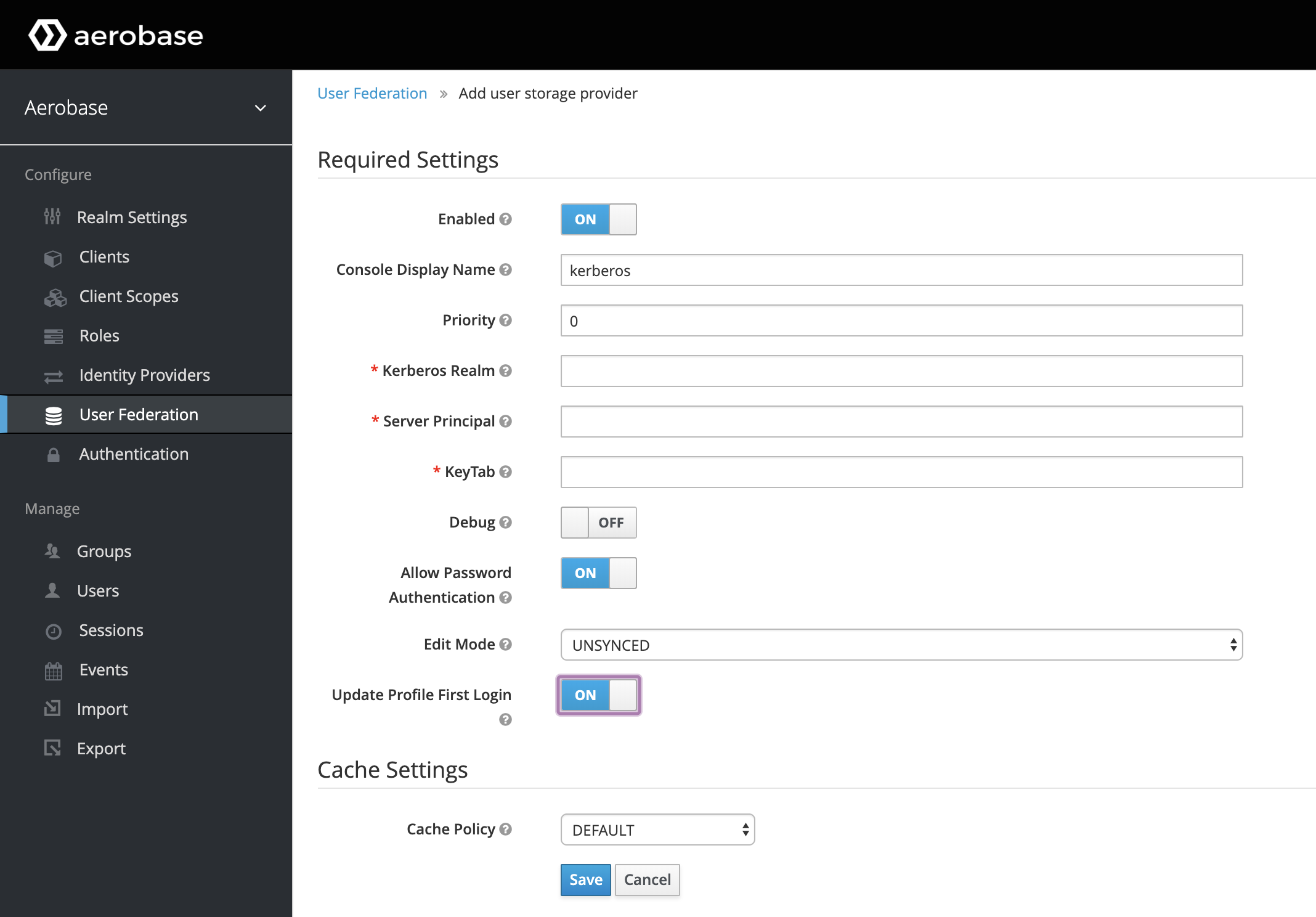
This provider parses the Kerberos ticket for simple principal information and does a small import into the local Aerobase database. User profile information like first name, last name, and email are not provisioned.
Setup and configuration of client machines
Clients need to install kerberos client and setup krb5.conf as described above.
Additionally they need to enable SPNEGO login support in their browser.
See configuring Firefox for Kerberos if you are using that browser.
URI .mydomain.org must be allowed in the network.negotiate-auth.trusted-uris config option.
In a Windows domain, clients usually don’t need to configure anything special as IE is already able to participate in SPNEGO authentication for the Windows domain.
Example setups
For easier testing with Kerberos, we provided some example setups to test.
Aerobase and FreeIPA docker image
Once you install docker, you can run docker image with FreeIPA server installed. FreeIPA provides integrated security solution with MIT Kerberos and 389 LDAP server among other things . The image provides also Aerobase server configured with LDAP Federation provider and enabled SPNEGO/Kerberos authentication against the FreeIPA server. See details here .
Cross-realm trust
In the Kerberos V5 protocol, the realm is a set of Kerberos principals defined in the Kerberos database (typically LDAP server).
The Kerberos protocol has a concept of cross-realm trust. For example, if there are 2 kerberos realms A and B, the cross-realm trust
will allow the users from realm A to access resources (services) of realm B. This means that realm B trusts the realm A.
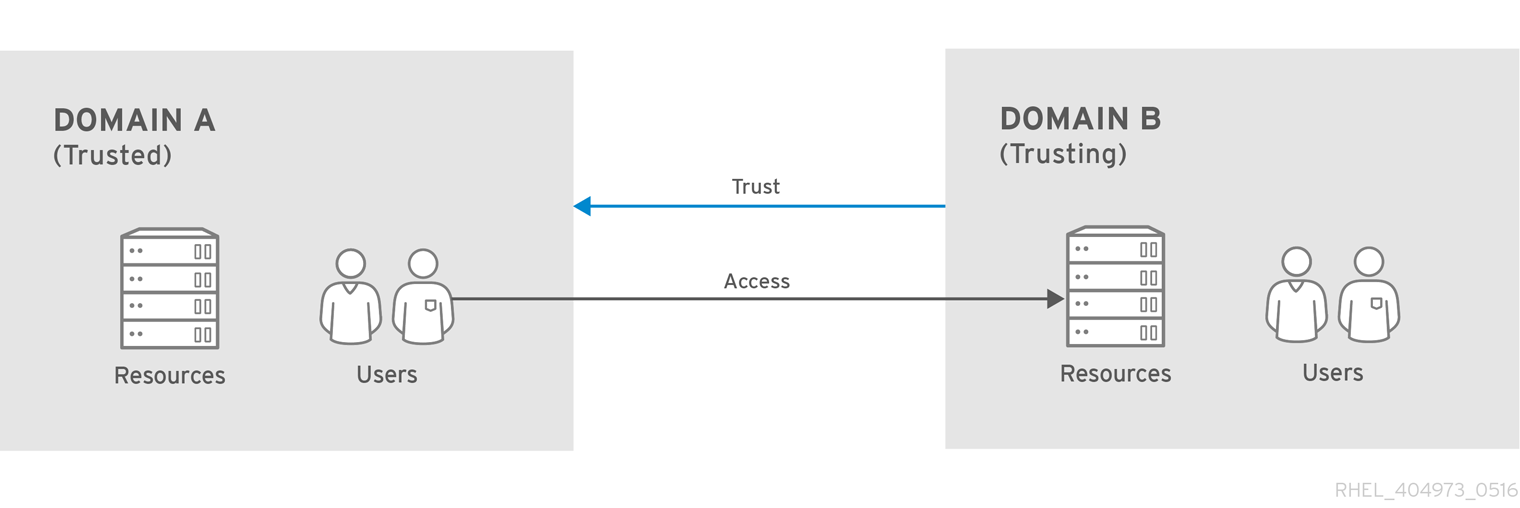
The Aerobase server has support for cross-realm trust. There are few things which need to be done to achieve this:
-
Configure the Kerberos servers for the cross-realm trust. This step is dependent on the concrete Kerberos server implementations used. In general, it is needed to add the Kerberos principal
krbtgt/B@Ato both Kerberos databases of realm A and B. It is needed that this principal has same keys on both Kerberos realms. This is usually achieved when the principals have same password, key version number and there are same ciphers used in both realms. It is recommended to consult the Kerberos server documentation for more details.
The cross-realm trust is unidirectional by default. If you want bidirectional trust to have realm A also trust realm B,
you must also add the principal krbtgt/A@B to both Kerberos databases. However, trust is transitive by default. If realm B
trusts realm A and realm C trusts realm B, then realm C automatically trusts realm A without a need to have principal krbtgt/C@A
available. Some additional configuration (for example capaths) may be needed to configure on Kerberos client side, so that
the clients are able to find the trust path. Consult the Kerberos documentation for more details.
|
-
Configure Aerobase server
-
If you use an LDAP storage provider with Kerberos support, you need to configure the server principal for realm B as in this example:
HTTP/mydomain.com@B. The LDAP server must be able to find the users from realm A if you want users from realm A to successfully authenticate to Aerobase, as Aerobase server must be able to do SPNEGO flow and then find the users. For example, kerberos principal userjohn@Amust be available as a user in the LDAP under an LDAP DN such asuid=john,ou=People,dc=example,dc=com. If you want both users from realm A and B to authenticate, you need to ensure that LDAP is able to find users from both realms A and B. We want to improve this limitation in future versions, so you can potentially create more separate LDAP providers for separate realms and ensure that SPNEGO works for both of them. -
If you use a Kerberos user storage provider (typically the Kerberos without LDAP integration), you need to configure the server principal as
HTTP/mydomain.com@Band users from both Kerberos realms A and B should be able to authenticate.
-
| For the Kerberos user storage provider, it is recommended that there are no conflicting users among kerberos realms. If conflicting users exist, they will be mapped to the same Aerobase user. This is also something, which we want to improve in future versions and provide some more flexible mappings from Kerberos principals to Aerobase usernames. |
Troubleshooting
If you have issues, we recommend that you enable additional logging to debug the problem:
-
Enable
Debugflag in admin console for Kerberos or LDAP federation providers -
Enable Kerberos logging:
-
For Windows OS, update the file:
C:\Aerobase\Runtime\unifiedpush-server\bin\standalone.conf.bat-
Update JAVA_OPTS
set "JAVA_OPTS=%JAVA_OPTS% -Djboss.bind.address.private=10.142.0.4 -Dsun.security.krb5.debug=true -Dsun.security.spnego.debug=true -Dspring.profiles.active=default"`
-
-
For Linux OS, update the file:
/var/opt/unifiedpush/unifiedpush-server/bin/standalone.conf`-
Update JAVA_OPTS
JAVA_OPTS="$JAVA_OPTS -Djboss.bind.address.private=172.17.0.6 -Dspring.profiles.active=default -Dsun.security.krb5.debug=true -Dsun.security.spnego.debug=true" `
-
-
SSO Protocols
The chapter gives a brief overview of the authentication protocols and how the Aerobase authentication server and the applications it secures interact with these protocols.
OpenID Connect
OpenID Connect (OIDC) is an authentication protocol that is an extension of OAuth 2.0. While OAuth 2.0 is only a framework for building authorization protocols and is mainly incomplete, OIDC is a full-fledged authentication and authorization protocol. OIDC also makes heavy use of the Json Web Token (JWT) set of standards. These standards define an identity token JSON format and ways to digitally sign and encrypt that data in a compact and web-friendly way.
There are really two types of use cases when using OIDC. The first is an application that asks the Aerobase server to authenticate a user for them. After a successful login, the application will receive an identity token and an access token. The identity token contains information about the user such as username, email, and other profile information. The access token is digitally signed by the realm and contains access information (like user role mappings) that the application can use to determine what resources the user is allowed to access on the application.
The second type of use cases is that of a client that wants to gain access to remote services. In this case, the client asks Aerobase to obtain an access token it can use to invoke on other remote services on behalf of the user. Aerobase authenticates the user then asks the user for consent to grant access to the client requesting it. The client then receives the access token. This access token is digitally signed by the realm. The client can make REST invocations on remote services using this access token. The REST service extracts the access token, verifies the signature of the token, then decides based on access information within the token whether or not to process the request.
OIDC Auth Flows
OIDC has different ways for a client or application to authenticate a user and receive an identity and access token. Which path you use depends greatly on the type of application or client requesting access. All of these flows are described in the OIDC and OAuth 2.0 specifications so only a brief overview will be provided here.
Authorization Code Flow
This is a browser-based protocol and it is what we recommend you use to authenticate and authorize browser-based applications. It makes heavy use of browser redirects to obtain an identity and access token. Here’s a brief summary:
-
Browser visits application. The application notices the user is not logged in, so it redirects the browser to Aerobase to be authenticated. The application passes along a callback URL (a redirect URL) as a query parameter in this browser redirect that Aerobase will use when it finishes authentication.
-
Aerobase authenticates the user and creates a one-time, very short lived, temporary code. Aerobase redirects back to the application using the callback URL provided earlier and additionally adds the temporary code as a query parameter in the callback URL.
-
The application extracts the temporary code and makes a background out of band REST invocation to Aerobase to exchange the code for an identity, access and refresh token. Once this temporary code has been used once to obtain the tokens, it can never be used again. This prevents potential replay attacks.
It is important to note that access tokens are usually short lived and often expired after only minutes. The additional refresh token that was transmitted by the login protocol allows the application to obtain a new access token after it expires. This refresh protocol is important in the situation of a compromised system. If access tokens are short lived, the whole system is only vulnerable to a stolen token for the lifetime of the access token. Future refresh token requests will fail if an admin has revoked access. This makes things more secure and more scalable.
Another important aspect of this flow is the concept of a public vs. a confidential client. Confidential clients are required to provide a client secret when they exchange the temporary codes for tokens. Public clients are not required to provide this client secret. Public clients are perfectly fine so long as HTTPS is strictly enforced and you are very strict about what redirect URIs are registered for the client. HTML5/JavaScript clients always have to be public clients because there is no way to transmit the client secret to them in a secure manner. Again, this is ok so long as you use HTTPS and strictly enforce redirect URI registration. This guide goes more detail into this in the Managing Clients chapter.
Aerobase also supports the optional Proof Key for Code Exchange specification.
Implicit Flow
This is a browser-based protocol that is similar to Authorization Code Flow except there are fewer requests and no refresh tokens involved. We do not recommend this flow as there remains the possibility of access tokens being leaked in the browser history as tokens are transmitted via redirect URIs (see below). Also, since this flow doesn’t provide the client with a refresh token, access tokens would either have to be long-lived or users would have to re-authenticate when they expired. This flow is supported because it is in the OIDC and OAuth 2.0 specification. Here’s a brief summary of the protocol:
-
Browser visits application. The application notices the user is not logged in, so it redirects the browser to Aerobase to be authenticated. The application passes along a callback URL (a redirect URL) as a query parameter in this browser redirect that Aerobase will use when it finishes authentication.
-
Aerobase authenticates the user and creates an identity and access token. Aerobase redirects back to the application using the callback URL provided earlier and additionally adding the identity and access tokens as query parameters in the callback URL.
-
The application extracts the identity and access tokens from the callback URL.
Resource Owner Password Credentials Grant (Direct Access Grants)
This is referred to in the Admin Console as Direct Access Grants. This is used by REST clients that want to obtain a token on behalf of a user. It is one HTTP POST request that contains the credentials of the user as well as the id of the client and the client’s secret (if it is a confidential client). The user’s credentials are sent within form parameters. The HTTP response contains identity, access, and refresh tokens.
Client Credentials Grant
This is also used by REST clients, but instead of obtaining a token that works on behalf of an external user, a token is created based on the metadata and permissions of a service account that is associated with the client. More info together with example is in Service Accounts chapter.
Aerobase Server OIDC URI Endpoints
Here’s a list of OIDC endpoints that the Aerobase publishes. These URLs are useful if you are using a non-Aerobase client adapter to talk OIDC with the auth server. These are all relative URLs and the root of the URL being the HTTP(S) protocol, hostname, and usually path prefixed with /auth: i.e. https://localhost:8080/auth
- /realms/{realm-name}/protocol/openid-connect/token
-
This is the URL endpoint for obtaining a temporary code in the Authorization Code Flow or for obtaining tokens via the Implicit Flow, Direct Grants, or Client Grants.
- /realms/{realm-name}/protocol/openid-connect/auth
-
This is the URL endpoint for the Authorization Code Flow to turn a temporary code into a token.
- /realms/{realm-name}/protocol/openid-connect/logout
-
This is the URL endpoint for performing logouts.
- /realms/{realm-name}/protocol/openid-connect/userinfo
-
This is the URL endpoint for the User Info service described in the OIDC specification.
In all of these replace {realm-name} with the name of the realm.
SAML
SAML 2.0 is a similar specification to OIDC but a lot older and more mature. It has its roots in SOAP and the plethora of WS-* specifications so it tends to be a bit more verbose than OIDC. SAML 2.0 is primarily an authentication protocol that works by exchanging XML documents between the authentication server and the application. XML signatures and encryption is used to verify requests and responses.
There are really two types of use cases when using SAML. The first is an application that asks the Aerobase server to authenticate a user for them. After a successful login, the application will receive an XML document that contains something called a SAML assertion that specify various attributes about the user. This XML document is digitally signed by the realm and contains access information (like user role mappings) that the application can use to determine what resources the user is allowed to access on the application.
The second type of use cases is that of a client that wants to gain access to remote services. In this case, the client asks Aerobase to obtain an SAML assertion it can use to invoke on other remote services on behalf of the user.
SAML Bindings
SAML defines a few different ways to exchange XML documents when executing the authentication protocol. The Redirect and Post bindings cover browser based applications. The ECP binding covers REST invocations. There are other binding types but Aerobase only supports those three.
Redirect Binding
The Redirect Binding uses a series of browser redirect URIs to exchange information. This is a rough overview of how it works.
-
The user visits the application and the application finds the user is not authenticated. It generates an XML authentication request document and encodes it as a query param in a URI that is used to redirect to the Aerobase server. Depending on your settings, the application may also digitally sign this XML document and also stuff this signature as a query param in the redirect URI to Aerobase. This signature is used to validate the client that sent this request.
-
The browser is redirected to Aerobase. The server extracts the XML auth request document and verifies the digital signature if required. The user then has to enter in their credentials to be authenticated.
-
After authentication, the server generates an XML authentication response document. This document contains a SAML assertion that holds metadata about the user like name, address, email, and any role mappings the user might have. This document is almost always digitally signed using XML signatures, and may also be encrypted.
-
The XML auth response document is then encoded as a query param in a redirect URI that brings the browser back to the application. The digital signature is also included as a query param.
-
The application receives the redirect URI and extracts the XML document and verifies the realm’s signature to make sure it is receiving a valid auth response. The information inside the SAML assertion is then used to make access decisions or display user data.
POST Binding
The SAML POST binding works almost the exact same way as the Redirect binding, but instead of GET requests, XML documents are exchanged by POST requests. The POST Binding uses JavaScript to trick the browser into making a POST request to the Aerobase server or application when exchanging documents. Basically HTTP responses contain an HTML document that contains an HTML form with embedded JavaScript. When the page is loaded, the JavaScript automatically invokes the form. You really don’t need to know about this stuff, but it is a pretty clever trick.
POST binding is usually recommended because of security and size restrictions. When using REDIRECT the SAML response is part of the URL (it is a query parameter as it was explained before), so it can be captured in logs and it is considered less secure. Regarding size, if the assertion contains a lot or large attributes sending the document inside the HTTP payload is always better than in the more limited URL.
OpenID Connect vs. SAML
Choosing between OpenID Connect and SAML is not just a matter of using a newer protocol (OIDC) instead of the older more mature protocol (SAML).
In most cases Aerobase recommends using OIDC.
SAML tends to be a bit more verbose than OIDC.
Beyond verbosity of exchanged data, if you compare the specifications you’ll find that OIDC was designed to work with the web while SAML was retrofitted to work on top of the web. For example, OIDC is also more suited for HTML5/JavaScript applications because it is easier to implement on the client side than SAML. As tokens are in the JSON format, they are easier to consume by JavaScript. You will also find several nice features that make implementing security in your web applications easier. For example, check out the iframe trick that the specification uses to easily determine if a user is still logged in or not.
SAML has its uses though. As you see the OIDC specifications evolve you see they implement more and more features that SAML has had for years. What we often see is that people pick SAML over OIDC because of the perception that it is more mature and also because they already have existing applications that are secured with it.
Docker Registry v2 Authentication
| Docker authentication is disabled by default. To enable see Profiles. |
Docker Registry V2 Authentication is an OIDC-Like protocol used to authenticate users against a Docker registry. Aerobase’s implementation of this protocol allows for a Aerobase authentication server to be used by a Docker client to authenticate against a registry. While this protocol uses fairly standard token and signature mechanisms, it has a few wrinkles that prevent it from being treated as a true OIDC implementation. The largest deviations include a very specific JSON format for requests and responses as well as the ability to understand how to map repository names and permissions to the OAuth scope mechanism.
Docker Auth Flow
The Docker API documentation best describes and illustrates this process, however a brief summary will be given below from the perspective of the Aerobase authentication server.
This flow assumes that a docker login command has already been performed
|
-
The flow begins when the Docker client requests a resource from the Docker registry. If the resource is protected and no auth token is present in the request, the Docker registry server will respond to the client with a 401 + some information on required permissions and where to find the authorization server.
-
The Docker client will construct an authentication request based on the 401 response from the Docker registry. The client will then use the locally cached credentials (from a previously run
docker logincommand) as part of a HTTP Basic Authentication request to the Aerobase authentication server. -
The Aerobase authentication server will attempt to authenticate the user and return a JSON body containing an OAuth-style Bearer token.
-
The Docker client will get the bearer token from the JSON response and use it in the Authorization header to request the protected resource.
-
When the Docker registry receives the new request for the protected resource with the token from the Aerobase server, the registry validates the token and grants access to the requested resource (if appropriate).